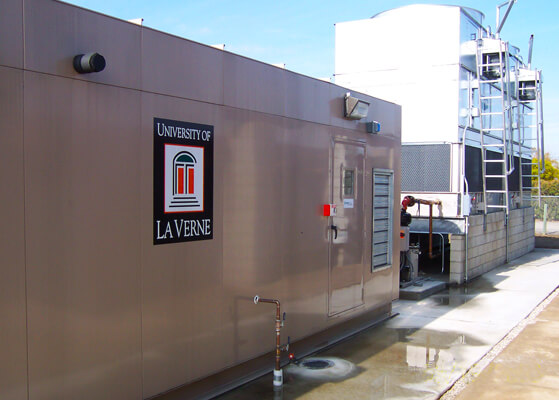Value Delivered
EMCOR Services Mesa Energy began working with the University of La Verne in 2005, providing comprehensive maintenance services. Because of our expertise and consistent responsiveness, they contracted us to recommend and install an upgraded modular system. The industrial chiller expansion we provided helps the client meet their most challenging current and future needs.
The client also asked us to help plan and implement a 10-year program, beginning with an assessment of all campus buildings. Our services enable reliable, high-performance facility operation, maximum energy efficiency and cost savings, and an optimum return on the client's facilities investment.
The solutions we provided allow the client to adjust to reduced requirements, rather than always operating at full capacity. An innovative control technology produces only as much chilled water as required, reducing their plant kilowatt-hour consumption by 40 percent.
The system not only allows the plant to ramp up and down proportionally to the campus cooling load, it also provides ample redundancy to meet maintenance and emergency requirements.
Their new direct digital control solution enables 24/7/365 monitoring with real-time display of continuous per hour and per month kilowatt-hour, carbon dioxide, and dollar savings. If performance drops below a pre-determined level, this system alerts operators to allow swift adjustments, helping to eliminate prolonged loss of savings. It also provides integrated card access and closed-circuit television for campus security monitoring from the same terminal.
Finally, our chiller design-build solution helped the client qualify for $15,000 to $20,000 in rebates from Southern California Edison.
Client Objectives
The client wanted to add required capacity to its HVAC system, while achieving the energy and cost savings available from the application of leading-edge technology.
Solutions
Initially, we recommended an HVAC solution designed to meet both current and future needs. That mechanical construction project, involving 10 buildings, included:
- Replacing 45 existing rooftop air conditioning units with chilled water air-handling units
- Installing a high-efficiency modular central plant
- Installing an underground chilled water piping distribution system capable of handling future growth
While that installation was to include two 400-ton industrial chillers, the client chose to install only one. However, a subsequent refrigerant leak that necessitated a costly chiller rental prompted re-evaluation of new, more energy-efficient technologies.
The single industrial chiller was running at near capacity, and the client was planning to add a new Abraham Campus Center, requiring 160 tons of additional capacity. To address this, we developed an innovative configuration that incorporates several of today's most advanced compressor and control technologies. Our solutions included:
- Supplementing the current 400-ton chiller with a 130-ton state-of-the-art Smardt chiller and Optimum Loop technology
- Installing a direct digital control system with graphics for fully automatic switchover and 24/7/365 monitoring
- Adding new iron foundation bracing
- Rigging the new chiller into the existing module
- Providing 480-volt power for the new chiller
- Running new condenser and chilled water piping to the chiller
- Installing automatic isolation valves required by the two chillers
- Installing two variable frequency drives with controls on the condenser water pumps
- Converting the pumping loop from primary/secondary to variable/primary to accommodate the Optimum Loop technology
- Overseeing chiller startup and testing it for maximum performance
Client Background
University of La Verne is a private institution founded in 1891 with total undergraduate enrollment of more than 2,400.
